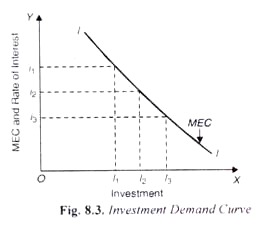INVESTMENT DEMAND
Meaning of Investment demand
In economics, investment means the new expenditure incurred on addition of capital goods such as machines, buildings, equipment, tools, etc by businesses in oder to increase or maintain its operations.
Types:
Investment is of three types:
is of three types:
1.Business Fixed Investment (i.e. investment in fixed capital, such as machines)
Fixed investment in economics refers to investment in fixed capital or to the replacement of depreciated fixed capital.It involves investment in physical assets such as machinery, land, buildings, installations, vehicles, or technology.
The more fixed capital is used per worker, the more productive the worker can be, other things being equal. For example, a worker who tills the soil only with a spade is normally less productive than a worker who uses a tractor-driven plough to do the same work, because with a tractor one can plough more land in less time, and thus produce more in less time, even if a tractor costs more than a spade. Obviously one would not normally use a tractor to plough a small garden, but in large-scale farming the income earned using a tractor by far outweighs the expense of using a tractor. It is not economical to use a spade for large-scale ploughing, unless the labour is extremely cheap, and the supply of labour is plentiful.
(2) Residential Investment i.e., investment in building of houses)
Residential fixed investment. Consists of purchases of private residential structures and residential equipment that is owned by landlords and rented to tenants.
(3) Inventory Investment (i.e. investment in building stocks of goods and raw materials)
Is the investment in raw materials, WORK IN PROGRESS and finished STOCK. Unlike fixed investments, inventories are constantly being ‘turned over’ as the production cycle repeats itself, with raw materials being purchased, converted first into work in progress, then into finished goods, then finally being sold.
The level of inventory investment made by a firm will depend upon its forecasts about future demand and its resulting output plans, and the amount of stock it needs to allow for delivery delays on raw materials and production delays in serving customers with appropriate buffer stocks to cover unforeseen contingencies. The cost of inventory investment includes order and delivery costs, deterioration and obsolescence of stock and interest charges on funds invested in